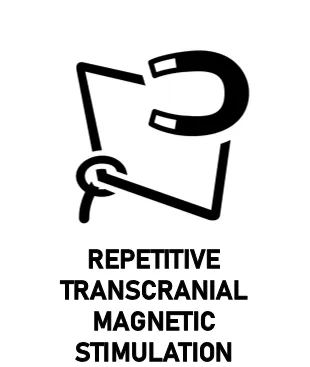Repetitive Transcranial Magnetic Stimulation (rTMS) is a type of therapy that can be used to treat an array of mental health conditions.
The therapy involves a trained therapist using a magnet in order to apply multiple magnetic pulses to the areas of the brain which are believed to be responsible for the regulation of mood and emotions – called neurotransmitters. In theory, the higher the level of these neurotransmitters, the better mood and emotions become.
It is very rarely used as a first line treatment, but if someone has little success in lessening their symptoms with a range of other treatments, then rTMS may be used.

The Science Behind Repetitive Transcranial Magnetic Stimulation
rTMS is a non-invasive form of therapy, though does not involve talking like more conventional mental health treatments do.
rTMS attempts to deliver multiple magnetic pulses to areas of the brain that are believed to be linked to the regulation of mood and emotion. The magnetic pulses stimulate these areas – called neurotransmitters.
The most widely accepted belief is that most mental health conditions are caused by a deficiency in neurotransmitters like serotonin and norepinephrine.
Therefore, rTMS seeks to address this deficiency. In theory, the higher the level of neurotransmitters, the more a mood improves.
How Does Repetitive Transcranial Magnetic Stimulation Work?
rTMS involves a patient sitting in a specially designed chair in each session – each of which usually last between 15 and 30 minutes.
The magnet targets the left side of the brain, and will remain in place for the duration of the session. Jerky movements are possible, but this shouldn’t happen enough to cause discomfort.
Other possible side effects of rTMS include fainting, a seizure or mild pain – though these are rare. A person does not need to be anaesthetised, and will not require to remain in hospital following the treatment.
A person will usually partake in rTMS sessions for a period of around 2-6 weeks, with sessions normally happening 4-7 times a week.
In order to maximise the effectiveness, it is important that a patient attends all sessions. It is also possible for rTMS to be combined with an antidepressant or a form of talking therapy.
The effectiveness of rTMS has been debated, but many people witness a reduction in the intensity of symptoms. Some attribute rTMS as being a ‘life-saver’. However, later re-occurrence of symptoms is a possibility.
When is Repetitive Transcranial Magnetic Stimulation Useful?
As rTMS targets the area of the brain that is believed to be crucial in the onset of the vast majority of mental health conditions, it has the potential to treat multiple mental health conditions.
It is best-known as a treatment for depression and anxiety, though other conditions that have been shown to react positively to rTMS includes schizophrenia, obsessive-compulsive disorder, and post-traumatic stress disorder.
rTMS also seems to help in treating those with a Substance-related disorder that have cravings [1]. It is important to state that rTMS won’t work for everyone.
How effective is Repetitive Transcranial Magnetic Stimulation?
Generally, research into rTMS is positive. Most research into rTMS has focused on its benefits for cases of depression. Multiple studies have produced evidence to show that rTMS can help treat depression effectively.
,A metanalyses into rTMS, which involved reviewing dozens of preexisting studies into depression and rTMS concluded that rTMS was indeed effective [2]. Further studies suggest rTMS can be useful in cases where antidepressants have not worked [3].
Research into the effectiveness of rTMS for Obsessive-compulsive disorder is mixed [4]. rTMS also appears to be very effective at treating the negative symptoms of Schizophrenia [5].
As discussed earlier, rTMS seems to be useful in reducing cravings in substance-related disorders [1]. Evidence also exists that suggests rTMS can be helpful in treating post-traumatic stress disorder [6].
Evidence does suggest however that ECT does tend to be more effective than rTMS [7][8]. While rTMS has proven effective for many, not everyone will gain relief from their symptoms. Everyone is unique.
For more information, consider reading our article on How Effective is Repetitive Transcranial Magnetic Stimulation (rTMS)?
How to find a therapist?
It is recommended that you contact your GP and inform them of your problems. They will refer you to the relevant mental health team.
If you are aiming to use the private sector, you could ask your GP or someone you know for a recommendation. You can also look online – the British Association for Counselling and Psychotherapy have a therapist directory on their site.
See Also
- Therapy Home
- Everything You Need To Know About Talking Therapy
- FAQ’s About Talking Therapy
- Repetitive Transcranial Magnetic Stimulation: Everything You Need to Know
- The Advantages and Disadvantages of Repetitive Transcranial Magnetic Stimulation
- 8 Things You Should Know About Repetitive Transcranial Magnetic Stimulation
- What Are The Side Effects of Repetitive Transcranial Magnetic Stimulation (rTMS)?
- How Effective is Repetitive Transcranial Magnetic Stimulation (rTMS)?
- Is Repetitive Transcranial Magnetic Stimulation (rTMS) Safe?
- How Do Repetitive Transcranial Magnetic Stimulation (rTMS) and Electroconvulsive Therapy (ECT) Compare?
Disclaimer
This website should be used purely for informational purposes, and does not intend to, nor should it ever, be used as a replacement for professional medical advice.
We strive to keep all of our pages updated, and ensure that our website is full of factual and in-depth information. However, we encourage you to browse this website with care.
As a reminder, this website and all content within it cannot and should not replace the advice of a trained medical professional. You can read our full disclaimer at this link.
Helplines
If you are struggling with your mental health, help is available. With the right support and treatment, you can make a recovery. For information on helplines, or if you are in a state of crisis, please visit our crisis page by clicking on the relevant link for your geographical location (United Kingdom), (United States), (International). You can also see how to get mental health treatment and the process involved by clicking this link.
References
[1] Wiegand, J., Kharraz, R., Bobbe, G., Sommer, G., Hajak, G., Wodarz, N. & Eichhammer, P. (2003). Repetitive Transcranial Magnetic Stimulation in Nicotine Dependence. Psychiatr Prax. 30 (2), p129-131.
[2] Bertschy, G. & Rachid, F. (2006). Safety and efficacy of repetitive transcranial magnetic stimulation in the treatment of depression: a critical appraisal of the last 10 years. Clinical Neurophysiology. 36 (3), p157-183.
[3] Rossini, D., Lucca, A,, Zanardi, R., Magri, L. & Smeraldi, E. (2005). Transcranial magnetic stimulation in treatment-resistant depressed patients: a double-blind, placebo-controlled trial.. Psychiatry Research. 137 (1), p1-10.
[4] Sarkhel, S., Sinha, V. & Praharaj, S. (2010). Adjunctive high-frequency right prefrontal repetitive transcranial magnetic stimulation (rTMS) was not effective in obsessive-compulsive disorder but improved secondary depression.. Journal of Anxiety Disorders. 24 (5), p535-539.
[5] Cohen, E., Bernardo, M., Masana, J., Arrufat, F., Navarro, V., Boget, T., Barrantes, N., Catarineu, S., Font, M. & Lomena, F. (1999). Repetitive transcranial magnetic stimulation in the treatment of chronic negative schizophrenia: a pilot study.. Journal of Neurology, Neurosurgery, and Psychiatry. 67 (1), P129-130.
[6] Grisaru, N., Amir, M., Cohen, H. & Kaplan, Z. (1998). Effect of transcranial magnetic stimulation in posttraumatic stress disorder: a preliminary study. Biological Psychiatry. 44 (1), p52-55.
[7] Berlim, M., Van den Eynde, F. & Daskalakis, Z. (2013). Efficacy and acceptability of high frequency repetitive transcranial magnetic stimulation (rTMS) versus electroconvulsive therapy (ECT) for major depression: a systematic review and meta-analysis of r. Depression and Anxiety. 30 (1), p614-623.
[8] Ren, J., Li, H. & Palaniyappan, L. (2014). Repetitive transcranial magnetic stimulation versus electroconvulsive therapy for major depression: a systematic review and meta-analysis. Progress in Neuro-Psychopharmacology & Biological Psychiatry. 51 (1), p181-189.






























